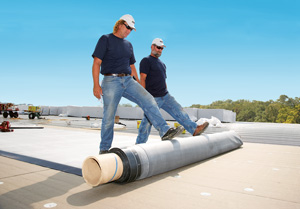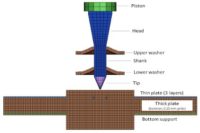Choosing a sustainable roofing system presents architects, building owners and specifiers with increasingly complicated decisions — changing government regulations, a proliferation of “green” products, and variations in roof color must all be weighed against cost considerations and design requirements. An important new measurement is emerging as a credible indicator of the overall sustainability of a roofing material – and one of the best guides to choosing a roof. It’s called Life Cycle Assessment, or LCA, and it provides a 360-degree view of a roofing material — from cradle to grave — providing an objective basis to make an informed decision. According to the American Center for Life Cycle Assessment, “Environmental Life Cycle Assessment is based on the very logical concept that if we knew all the environmental impacts of a product or service, we could make good environmental decisions about that product or service.”

|
|
EPDM roofing membrane accounts for more than 1 billion square feet of new roof coverings in the United States each year. Today, there are well over 500,000 warranted roof installations totaling more than 20 billion square feet of EPDM membrane in place nationwide. (Photo courtesy of Carlisle Construction Materials.) |
LCA’s are based on the idea that to measure a product’s environmental impact, it is necessary to take a look at all stages related to the product’s life cycle, from cradle to grave, or, more accurately, from raw material extraction and processing, through product manufacture, installation, use, maintenance, removal and disposal via recycling or landfill. An assessment also includes transport throughout the life cycle of the product.
The structure of the LCA study itself is typically four-fold:
• Goal and scope definition — in other words, what will be learned?
• Life Cycle Inventory, or what goes into making the product?
• Life Cycle Impact Assessment (LCIA), or what are the environmental impacts over the life cycle of a product?
• And finally, data interpretation, or what does it all mean?
It is especially important to note that a Life Cycle Assessment is most valuable as a comparative tool, providing a comprehensive assessment of alternative materials on a broad range of environmental issues.
The EPDM Roofing Association (ERA) invested in an LCA to generate valuable, scientifically grounded information about both black and white EPDM membranes when compared to other frequently used low-slope roofing products. The ERA wanted to determine the specific environmental impact of EPDM compared to other roofing materials, and to cut through a broad range of anecdotal evidence and “green” claims that impact building professional decision making processes regarding roofing material selection.
The LCA Process
There were several key considerations in generating the LCA. First, ERA chose to work with a consulting firm with extensive LCA experience. Since LCA is a complex process, virtually all companies and organizations must work with outside consultants to design and conduct the study. ERA chose the GreenTeam, Inc. of Tulsa, Okla. Industry professionals recommend working with a consultant certified by the ACLCA (American Center for Life Cycle Assessment) to ensure that the finished study meets the highest professional standards.
Second, the study was designed to encompass a broad range of competing products in various thicknesses to ensure that the data yielded the most valuable information possible. To have as broad a comparison as possible, a variety of application methods were incorporated into the study, including loose laid ballast, fully adhered, and mechanically attached. The study also evaluated ancillary materials used for system installation, such as metal fasteners, membrane bonding adhesive and ballast stone. In recent years, EPDM has been recycled with excellent results, but these activities have only recently been implemented and were not included in the LCA.
Third, the GreenTeam made an exhaustive review of existing sources of information about materials in the study, including previous LCA studies, information about membrane composition, emission factor data supplied by the US Environmental Protection Agency (EPA), and existing LCI (Life Cycle Inventory) databases. An LCI database is an online repository for data collected on commonly used materials, products or processes.
Fourth, the LCA, as generated by the GreenTeam, used a widely respected industry standard to measure the various environmental impacts of the roofing systems. This standard is known as TRACI (Tool for the Reduction and Assessment of Chemical and Other Environmental Impacts) and was developed by the EPA, identifying factors of impact on the environment such as global warming, acid rain, respiratory effects and ozone depletion. In addition, the TRACI methodology also identifies specific measures for each impact. Although a number of atmospheric gasses including methane and various gaseous oxides may contribute to global warming, the TRACI scale measures all of these impacts in terms of their equivalency to carbon dioxide (CO2), the most common greenhouse gas. By using TRACI, the study tapped into an objective and scientifically proven method to compare the relative impact of the products in the study.
Fifth, it was essential to work with neutral professionals respected in the building industry to interpret the results of the LCA, and generate an LCIA or Life Cycle Impact Assessment. ERA selected Tegnos Research, a firm with extensive experience in providing services to the building envelope industry. A comparative review of the TRACI impact data for each of the roofing systems was completed, keeping in mind the original goal of the LCA: to assess the specific environmental impacts of EPDM compared to other widely used roofing systems. Given this goal, a focus was placed on energy-related categories such as global warming potential (GWP), measured by kilograms of CO2. The equivalent results varied widely, with a low of 22.4 kg per square foot for fully adhered white non-reinforced EPDM. The relevance of the global warming category is further supported by the degree of differences exhibited by the membranes studied.
Study Recommendations
Tegnos also reviewed the data related to the attachment method, membrane color and service life, with recommendations for use of the study, and considerations for moving forward.
First, it was recommended that widely used industry LCI’s — especially the Athena Sustainable Materials Institute LCI database and ®EcoCalculator — be revised to reflect the accurate EPDM data generated by this study. Specifically, this meant incorporating the information that the current formulation of the product produces a significantly lower overall environmental impact than had previously been reported. ERA contacted Athena, provided the updated EPDM data, and the Athena LCI database was revised. Tegnos also recommended that the new data should also be submitted to the US LCI database for use with the Building for Environmental and Economic Sustainability (BEES®) and other LCA tools.
Secondly, Tegnos emphasized that this study was service life neutral — in other words, it assumed that all of the products tested would last for the same amount of time, even though there is significant variation among the durability of these roofing systems. Tegnos pointed out that, “if a roofing system with a relatively low initial GWP is being compared against a roofing system with a significantly higher GWP, the data in this study suggests that it would be prudent for the designer to be confident that the higher GWP system can provide a significantly longer service life in order to be considered an equivalent in terms of global warming impact.” Put another way, according to the LCA, black EPDM becomes carbon neutral after 19 years. Recent testing, also undertaken by ERA and conducted by an independent agency, showed that EPDM roof samples in place for between 28 to 32 years have physical characteristic properties above or just below the minimum physical characteristics of newly manufactured 45-mil EPDM membrane. Armed with the relatively low GWP of EPDM shown by the LCA study, as well as the longevity of EPDM demonstrated in the concurrent Long Term Service Life study, ERA has compelling data to educate the roofing industry about the overall sustainability of the product.
Based on the ERA experience with LCA, there are several lessons for the roofing professional. First and foremost, LCA is an increasingly important measurement of sustainability being used by the building industry. Increasingly, architects will need to be conversant about LCA, and building owners will want to see the hard data about building products that support their choices. Second, if you choose to conduct an LCA, be very clear about your goals, and be as inclusive as possible in your study design. Seek counsel from the best in the business to conduct the study, and interpret it. Third, update your data as needed. For instance, Johns Manville has just joined Carlisle SynTec and Firestone Building Products as a manufacturer of EPDM and — as a result — ERA will update its LCA. And finally, leverage the investment you made in your LCA to guide your choices, inform your clients about your decisions, or inform the building industry as a whole about the true sustainability of your product. At a time when green claims abound, data that is grounded in science will stand out in the crowd and provide the building community with the tools they need to make responsible decisions that will at the same time benefit the environment — and their bottom line.


